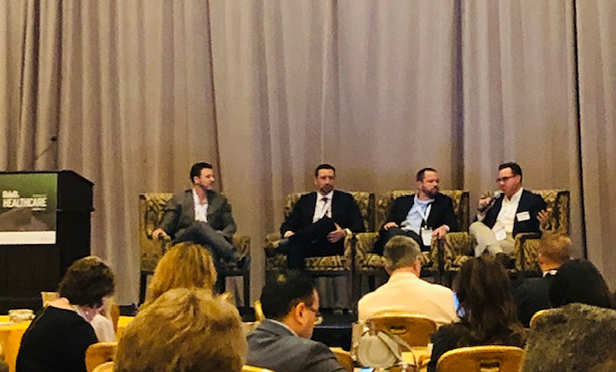 SCOTTSDALE, AZ—The healthcare services market has become increasingly attractive for private equity investors due to the fragmented structure of the field. In fact, according to panelists at the recent GlobeSt. Healthcare Real Estate event, over the past 20 years private equity involvement in healthcare has grown so much that it has become an integral part of the healthcare ecosystem, posting billions of dollars in deals last year alone.
SCOTTSDALE, AZ—The healthcare services market has become increasingly attractive for private equity investors due to the fragmented structure of the field. In fact, according to panelists at the recent GlobeSt. Healthcare Real Estate event, over the past 20 years private equity involvement in healthcare has grown so much that it has become an integral part of the healthcare ecosystem, posting billions of dollars in deals last year alone.
The equity panel at the event discussed available capital, common deal structures, high areas of interest for investors and what to know when considering private equity funds.
When moderator Chris Wadley of JLL asked why the flow of equity in healthcare real estate is increasing, the answers were many and varied. Ben Ochs, CEO of Anchor Health Properties, said that institutions are finding it challenging in general and healthcare is continuing to develop as a niche asset class. "As we are reaching the end of the cycle, people are seeing healthcare as a safe place to invest capital and find enhanced yield in healthcare as compared to other asset classes."
For panelist Jon Foulger, director of acquisitions at MedProperties, the answer is that institutional investors are looking for consistency.
So what kinds of products are they chasing? According to Foulger, his high net worth investors have been willing to go higher on the risk curve. As for the risks, Ochs added that there might be issues with some older assets and whether they are functionally going to survive.
To that comment, Matt Bear, founder of Bear Real Estate Advisors, noted that one of his clients won't buy buildings if they have a pitched roof. "Functional obsolescence is real."
Foulger thinks that the healthcare growth is more about comparative asset classes. "It is relative and there is still some level of sanity in underwriting healthcare real estate."
But moderator Wadley warned that with construction prices going up 10% over the next 10 years, it is important to really be mindful of what you are building.
"You have to understand your operator and make sure there is a good business model there," added Ochs. "You have to understand the true demand for a facility and the location. Folks are becoming wiser as they are thinking about investments. In terms of real estate investors, if we are going to develop or contemplate purchasing one, you really need to peel back the layers and make sure it works."
In terms of how to distinguish yourself from the market competitors, Ochs said it is about being innovative, having speed to execution and low cost to capital. "We try to understand the opportunity first and foremost. Then we will marry up the right capital with it."
Foulger added that it is a relationship business at its core but it is also a nuanced market. "There is quite a bit of obsolete real estate that comes on the market and there is a reason they aren't trading. When looking at development, I think hospital systems are getting smarter. You have to have a balance of acquisition and development." He also said that investors are trying to get further out on the risk curve and are leaning on operating partners a little bit more.
© Touchpoint Markets, All Rights Reserved. Request academic re-use from www.copyright.com. All other uses, submit a request to [email protected]. For more inforrmation visit Asset & Logo Licensing.







